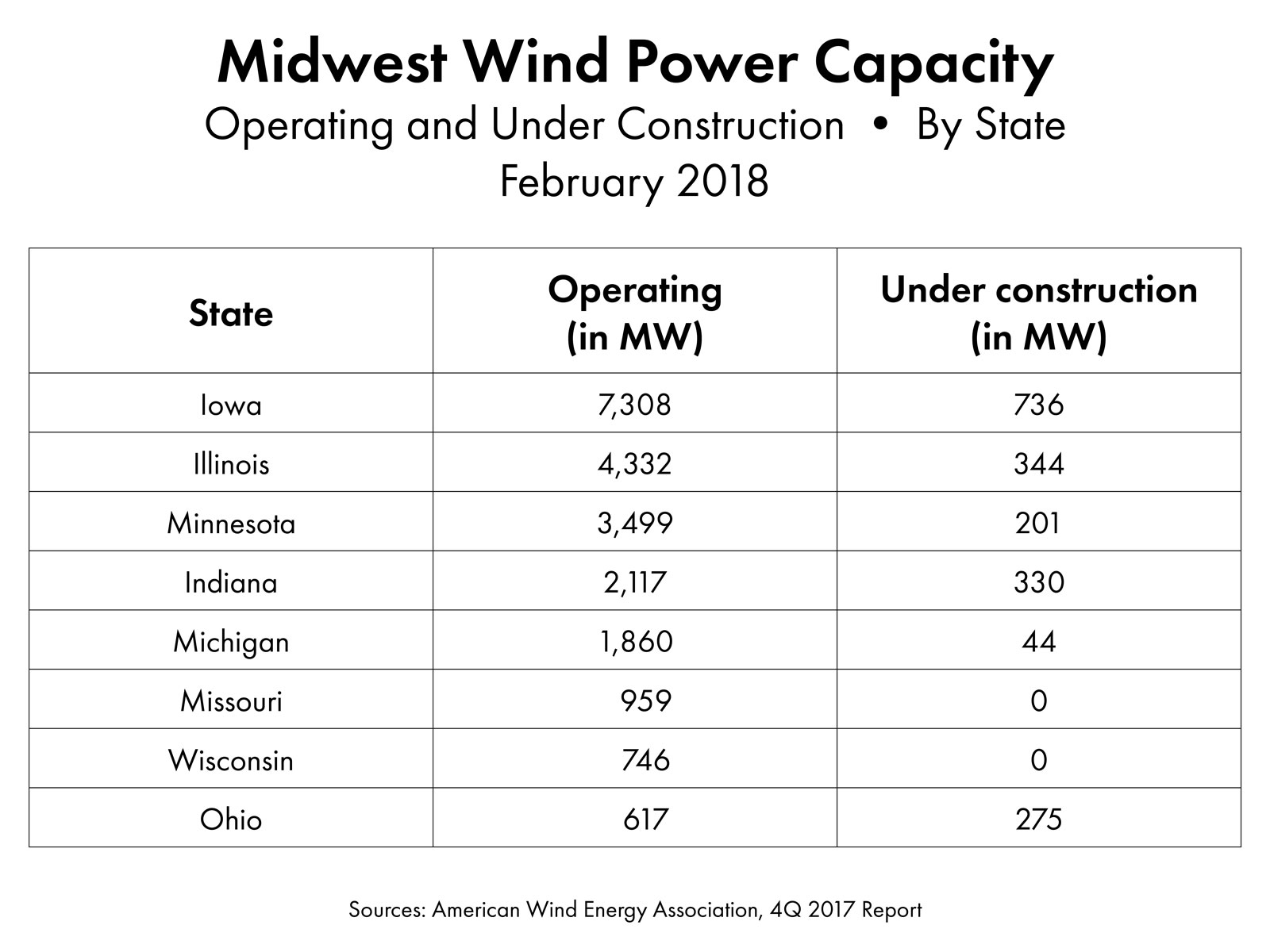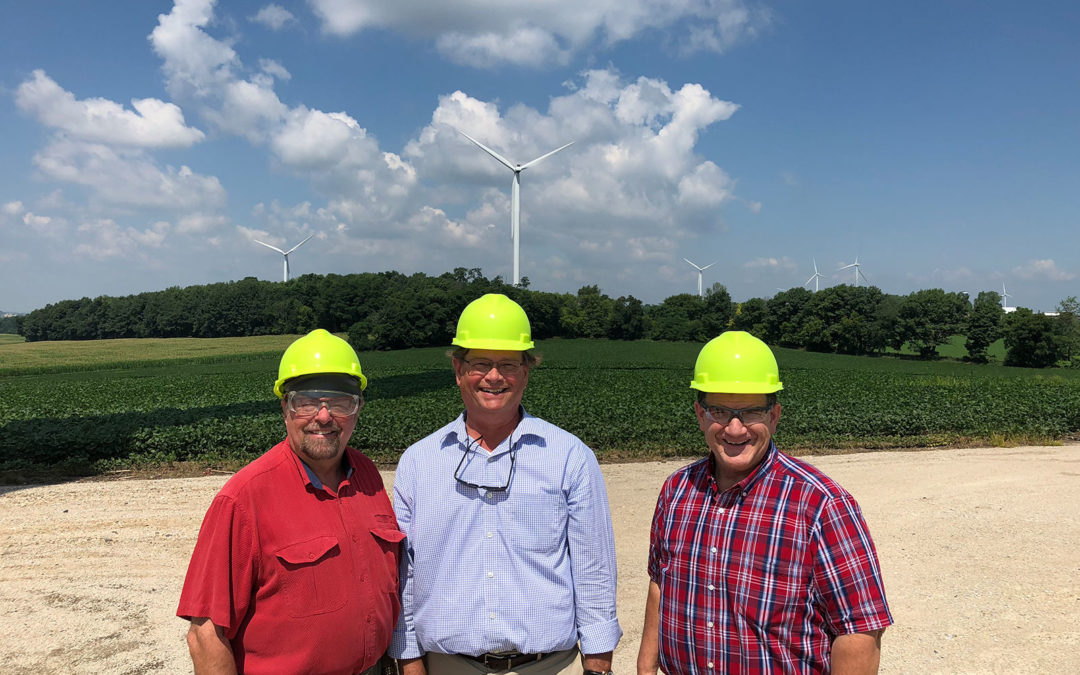
by Jim Boullion | Jul 30, 2018 | Events, Hydroelectric, RENEW Wisconsin, Renewables, Solar, Wind
Cedar Ridge Wind Farm
On July 24th Alliant Energy hosted a tour of their Cedar Ridge Wind Farm in Fond du Lac County for several state legislators to discuss not only wind, but all of the latest developments in renewable energy. Built in 2008, Cedar Ridge was one of the first wind installations in the state. Alliant Energy owns and operates this site of 41 turbines that has a capacity of generating 68 mW of electricity, enough to power 17,000 homes. In its 10 years of existence, Alliant calculates that the electric power generated by these wind turbines allowed them to avoid burning enough coal to fill a 99-mile-long coal train! Alliant currently owns 569 mW of total wind power, but because of falling costs, efficiency gains of the turbines, and inexpensive operations and management, they expect to invest in an additional 1,150 mWs of wind generation by 2021. Representatives Bob Kulp and Rick Gundrum came away impressed and posted very positive comments online about the tour and the many developments in renewable energy.
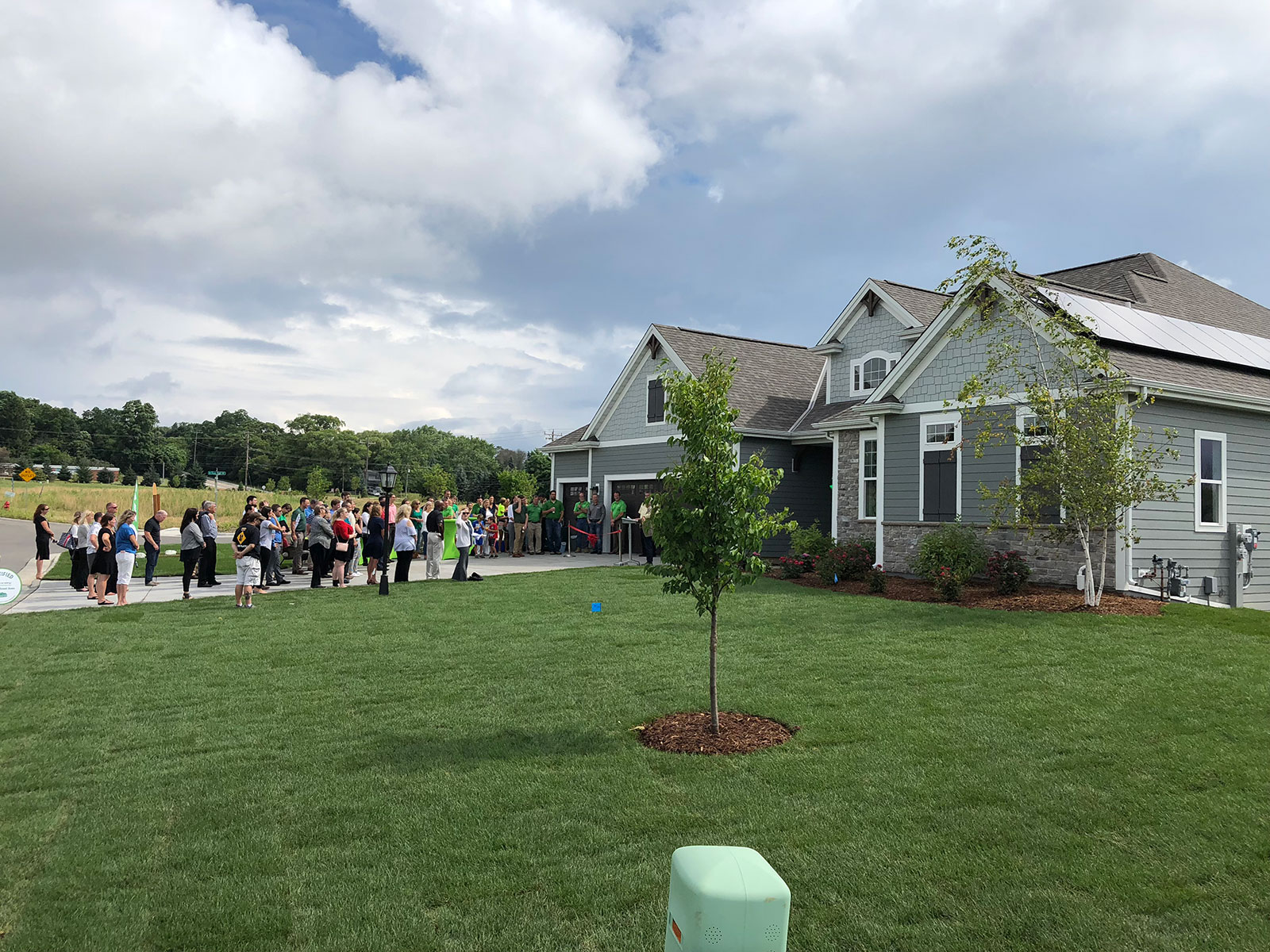
Tim O’Brian Homes Net Zero Community
On July 20th I visited a ribbon cutting for the new Tim O’Brian Homes Net Zero Community in New Berlin. This all-solar subdivision is the first of its kind in Wisconsin. In partnership with Neumann Companies and SunVest Solar, Inc., they are developing the Red Fox Crossing subdivision with a focus on sustainability and energy efficiency. Not only is every home in the subdivision designed from the ground up to include 6 to 8 kW photovoltaic solar arrays, but they are also certified ENERGY STAR® V3 National Qualified Homes. “Buyers are looking for ways to save on their true cost of homeownership,” says Angela Cooper, Milwaukee Division President of Tim O’Brien Homes. “The upfront costs of building a net zero home might be slightly more than a code-built home but the money saved in monthly utility bills results in an overall less expensive home.” The subdivision has been popular, with half of the 34 units already sold. “Red Fox Crossing has the potential to be the turning point in building a more sustainable community in Wisconsin, versus focusing on only one home at a time,” says Tim O’Brien, President of Tim O’Brien Homes. ”

Badger Hydroelectric Plant
On July 13th I joined State Senator Rob Cowles (District 2-Green Bay) and Representative Dave Murphy (District 56-Greenville) on a tour of the Badger Hydroelectric plant in Kaukauna. The visit was hosted by the Kaukauna Municipal Utility, a member of WPPI Energy. As noted in this WBAY news story, the visit was designed as a discussion about renewable energy of all kinds. Hydroelectric power was one of the first, and least expensive sources of electric power. The Kaukauna facility is 110 years old and had a major upgrade in 2013, giving it a capacity of 7 mW of power, up 40% from the capacity of its two old powerhouses. During the meeting we discussed the dropping prices for wind and solar power and the tremendous amount of renewable energy that is currently listed on the 4-year MISO planning queue. It was noted that WPPI Energy, Dairyland Power and the investor owned utilities are looking to close their coal burning power plants and invest in utility scale wind and solar projects. They are doing this because wind and solar cost less than coal and the rising customer demand for renewable energy. This competitive, market-driven demand for renewable energy has led Wisconsin to easily surpass the 10% Renewable Portfolio Standard (RPS) that was established by the state legislature in 2006, and shows no signs of slowing!

Governor Walker Helps Energy Bank Announce Renewable Energy Lighting
On July 9th I was invited by Energy Bank, Inc. to attend the unveiling of a new product called FUSION. Neal Verfuerth, owner of Energy Bank, invented this new lighting system that uses the DC power output from photovoltaic solar panels to directly energize LED fixtures – without conversion to AC. Governor Scott Walker gave the keynote speech where he said Wisconsin companies understand the need to keep their peak energy demand low and reduce the overall cost of energy to be economically viable. Walker said that businesses understand that “to be environmentally sustainable, you need to be economically sustainable”, and products like FUSION make that happen. The Governor was excited about innovative and high-tech companies like Energy Bank locating in Wisconsin, creating the new era technologies that will create jobs and attract millennial workers to Wisconsin. I had a few minutes to speak with both the Governor and Representative Paul Tittl (District 25-Manitowoc) at the end of the event about the exciting advancements and fast falling prices that renewable energy has had in the last few years. They were very interested and are looking forward to working with RENEW to help keep that momentum going.
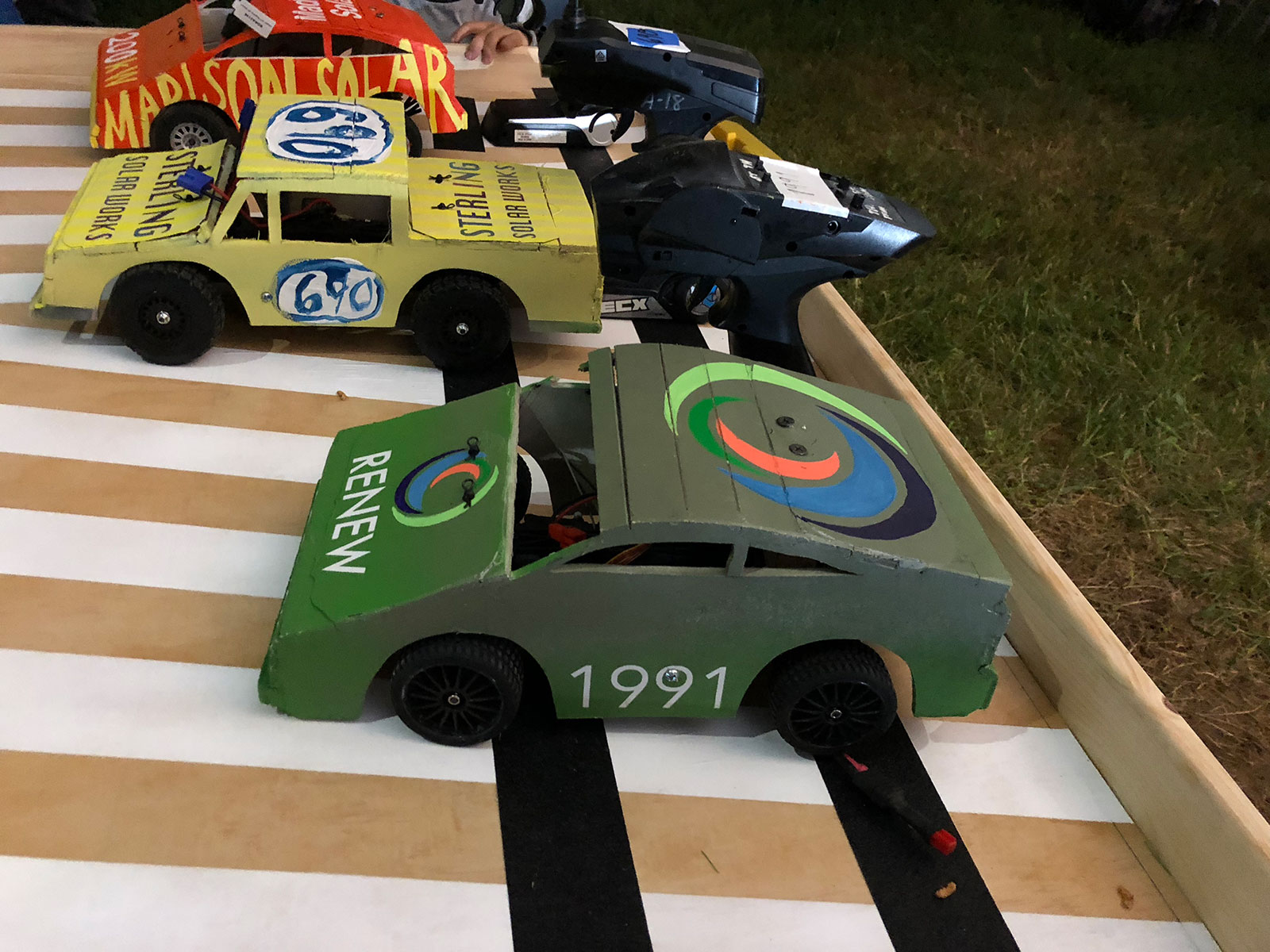
The 29th Annual Energy Fair
On the weekend of June 15-18 I had the pleasure of visiting the MREA Energy Fair in Custer. This was my first visit to the Energy Fair and all I can say is that I was blown away! They had an amazing number of great seminars (over 250) on renewable energy, energy conservation and sustainable practices of all kinds. I was able to see, sit in and learn about many different electric vehicles (over 70 of them were on-site) and discuss with EV aficionados what the exciting future of transportation might look like. There were also over 450 exhibitors, presenters and sponsors from around the country. There were great speakers, entertainment and interesting people everywhere you looked. Everyone was up-beat and excited about renewable energy and how quickly it is taking over the energy market. Finally, the most fun part of the weekend was having me drive the RENEW Wisconsin electric demolition derby car. I won my initial heat and was in the final event. A controversial call by the umpires and a slight miscalculation on my part kept me out of the winner’s circle, but at the end of the evening everyone was a winner and we all had a great time!!
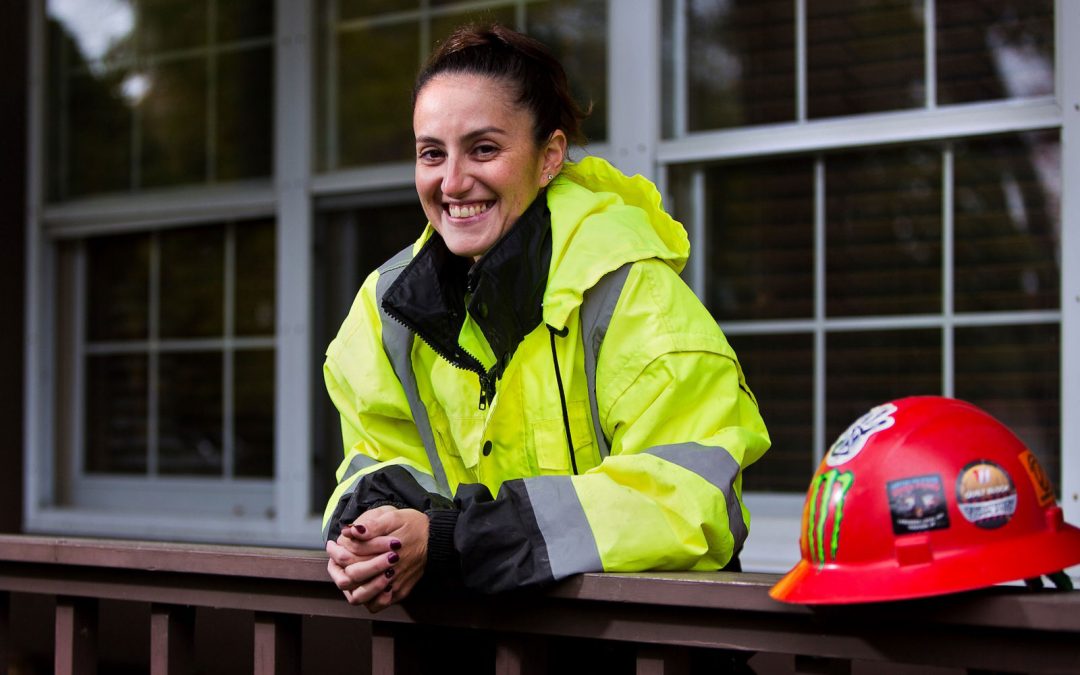
by Jodi Jean Amble | Jul 25, 2018 | RENEW Wisconsin, Renewables, Solar, Wind
Last fall, I was asked to help promote a series called Names behind the Numbers, profiling Wisconsin’s renewable energy workers. One of the interviews featured April Smith (pictured above), a construction worker on the Quilt Block Wind Farm in Darlington, WI. In describing her work she said “All the people, the company, and the community — everyone looked out for each other” and I thought “that’s Wisconsin.”
I grew up in the northeast corner of Iowa County, in the Wisconsin River valley in a small town called Arena. My grandmother cleaned houses, my dad was a mechanic turned landscaper, and my uncles worked road construction. I was surrounded by the grit and community that defines the Wisconsin work ethic; I was taught to work hard, work together, and get the job done.
Now I am one of Wisconsin’s clean energy workers. I joined the RENEW Wisconsin staff a year ago with an untraditional background: an arts education, a theater and music career, and eight years of marketing for a general contractor in Chicago. I knew little about renewable energy, but I cared about the environment and wanted to help build a cleaner future for my children.
According to the Department of Energy’s 2017 US Energy and Jobs Report Wisconsin, over 67,000 people are already working in clean energy, and renewable energy job growth is six times faster than overall job growth in the state. Wisconsin has the opportunity to increase renewable energy substantially in the coming decades, and create tens of thousands of jobs along the way.
After April’s story was published, I was able to attend the Quilt Block dedication and ribbon cutting in Darlington, WI. I witnessed firsthand a community (comprised of local landowners, businesses, educators, government officials, and EDP Renewables) working together to build a 98 MW wind farm, enough to power 25,000 Wisconsin homes with clean energy. This project created approximately 100 full-time jobs during construction and 12 permanent jobs.
I recently attended an outdoor BBQ at the local office of the proposed Badger Hollow Solar Project in Monfort, WI. This was an opportunity for local landowners to get together and see which of their neighbors would be growing a solar crop. There, I met Tracy Fillback, the local liaison hired to address questions and concerns from the landowners and the community as this project progresses. She spent the last few years at home raising her children and now she’s starting a new chapter as part of of the Badger Hollow Solar project. She is another example of renewable energy job opportunity in Wisconsin.
Wind developers are scoping out new projects in rural parts of the state and in recent weeks two proposals for large scale solar farms have joined Badger Hollow Solar at the review stage of development. While we can’t predict the exact number of jobs this will mean for Wisconsin, these companies and workers will spend millions of dollars on locally-sourced gravel, concrete, construction supplies, food, lodging and other services. Increasing renewable energy is one of the best economic development moves Wisconsin could make, particularly for its rural communities.
Wisconsin’s renewable energy workers are building a cleaner future for our children and they’re doing it the Wisconsin way; with tenacity, community, and hard work. Renewable energy can support our local economies and be as homegrown as the crops in our fields, if our communities can continue to embrace the possibilities.
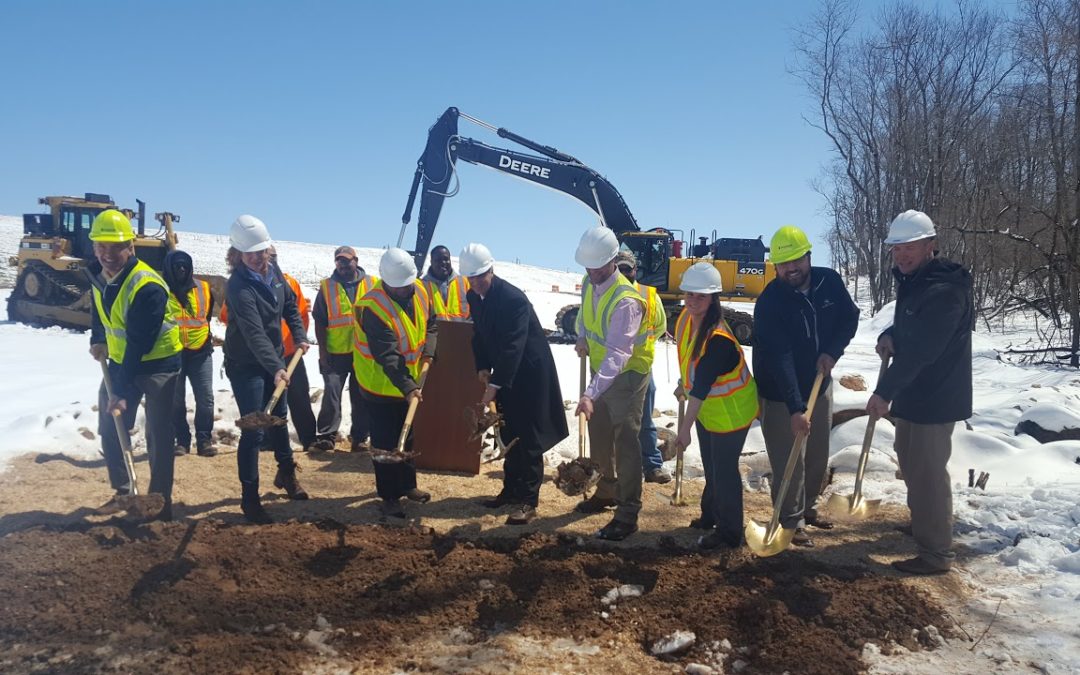
by Michael Vickerman | Apr 20, 2018 | Biogas, Renewables, Solar, Wind
In the spirit of leading by example, Dane County launched two separate and distinct initiatives this week to power its own operations with clean energy resources. One initiative involves becoming a co-investor in solar and wind projects that will supply Dane County offices with zero-emission electricity. The County will issue a Request for Proposals in early May.
The other project, with an estimated price tag of $25 million, will clean up the methane coming from the Yahara landfill and several local dairy farms and convert it into compressed methane fuel for the County’s vehicle fleet. RENEW member businesses BioFerm and Clean Fuel Partners are part of the team of contractors developing this project. Construction of the project will commence this spring, and should wrap up in the first half of 2019.
County Executive Joe Parisi circulated an email summarizing the renewable energy initiatives detailed below.
Good morning,
As we approach Earth Day this weekend, it is my pleasure to share with you exciting news of two projects that continue to make Dane County a leader in renewable energy in Wisconsin.
This week I announced that Dane County will seek partners in the coming weeks to help develop new solar and wind farms across Wisconsin. It’s our latest investment in clean, renewable energy in an effort to improve efficiency and reduce climate change causing emissions. The county will release a request for proposals, seeking offers from prospective solar and wind developers on projects Dane County could become an investor in. Projects will be evaluated this summer, with recommendations made in time for 2019 budget preparations. The goal is to facilitate the development of projects that generate renewable electricity to offset the amount of energy used to run county operations. In turn, keeping with the county’s benchmark of being 100% sustainable.
And yesterday, I helped kick off construction for an innovative project that will turn garbage and cow manure into renewable fuel for thousands of vehicles across the region and country. This project is also expected to significantly increase our lakes clean-up efforts by increasing revenue opportunities for local biogas digesters. Taking cow manure and garbage and turning it into vehicle fuel is good for the air we breathe, the waters we fish and swim in, and county taxpayers. We are committed to accelerating work to clean up our lakes and financing efforts to produce renewable energy, and this project does both.
Design work of the new facility is complete and the remainder of the project is out for bid now. Construction is expected to begin in the coming weeks with the system online by spring of 2019. This project is the first in the nation to be able to receive biogas from multiple off-site locations and connect that renewable gas with CNG gas stations locally and across the nation.
For more information, please see the full releases below and the links to the media stories:
Renewable Proposals: http://host.madison.com/wsj/news/local/govt-and-politics/dane-county-to-seek-proposals-for-funding-private-renewable-energy/article_87ca0f31-9879-57fa-bc8e-4fca47a35006.html
Landfill Facility: http://www.nbc15.com/content/news/Groundbreaking-of-23-million-landfill-project-480315243.html
In partnership,
Joe Parisi
Joseph T. Parisi
Dane County Executive
Dane County Seeks Partners to Develop Solar, Wind Projects Across Region, State
County Executive Joe Parisi announced today that Dane County will seek partners in the coming weeks to help develop new solar and wind farms across Wisconsin. It’s the latest investment in clean, renewable energy by the County Executive who’s prioritized installing solar at county facilities, most recently making up to 40 acres of land at the Dane County Regional Airport available for solar, all in an effort to improve efficiency and reduce climate change causing emissions.
“Dane County is leading the way for renewable energy in Wisconsin,” said Dane County Executive Joe Parisi. “This is the right thing to do for our environment, for our economy and for taxpayers. This project will increase local clean energy jobs, will reduce carbon emissions and ease the burden for taxpayers.”
In the coming days, the county will release what’s called a request for proposals, seeking offers from prospective solar and wind developers on projects Dane County could become an investor in. Projects will be evaluated this summer, with recommendations made in time for 2019 budget preparations. The goal is to facilitate the development of projects that generate renewable electricity to offset the amount of energy used to run county operations. In turn, keeping with the county’s benchmark of being 100% sustainable.
Dane County currently owns more solar than any other public entity in the state with nearly 600 kW at 15 sites across the county, not including the upcoming Airport Project which will be the largest public sector project in Wisconsin. That project could generate over 8 megawatts of power, almost three times more than the largest solar project currently operating in the region, a 2.25 megawatt facility in Beloit.
http://dane-county-airport.com/
In addition to the airport, Parisi’s budgets have funded solar projects at the Dane County Job Center, the new East District Highway Facility and Medical Examiner’s Complex, the offices of Dane County Land and Water Resources, the Dane County Library Service and others. Additional future solar projects are planned for the Alliant Energy Center.
The new solar projects will reduce carbon dioxide emissions by the equivalent of taking 1700 cars off the road, reducing direct energy costs by over $2.1 million over the next two decades. The new Dane County East District Highway Garage that opened last year has well over 800 solar panels and is the second largest municipally-owned solar project in the state.
In addition to the solar developers, the project will employ local electricians and construction workers. There are more than 2,800 people employed in the solar industry in Wisconsin and 460 in Dane County, according to the Solar Foundation, which tracks solar jobs nationwide. Dane County is second only to Milwaukee County in the number of solar jobs in Wisconsin.
Expanding the county’s investment in solar projects will help continue the county’s tradition of being 100% sustainable. For more than the past two decades, Dane County has generated renewable electricity at its landfill, fueled by the naturally occurring methane given off by the waste. Presently, the landfill makes enough electricity to power 4,500 homes.
The county has initiated an innovative project to instead convert this methane into clean burning vehicle fuel, to further reduce carbon emissions by thousands of tons, the primary contributor to climate change causing greenhouse gases. In addition to helping Dane County achieve nearly 100% renewable status, the two landfills since 1998 have earned over $35 million for taxpayers thru the sale of renewable electricity. The County’s total renewable power generation reduces CO2 emissions the equivalent of taking over 5,200 cars off the road.
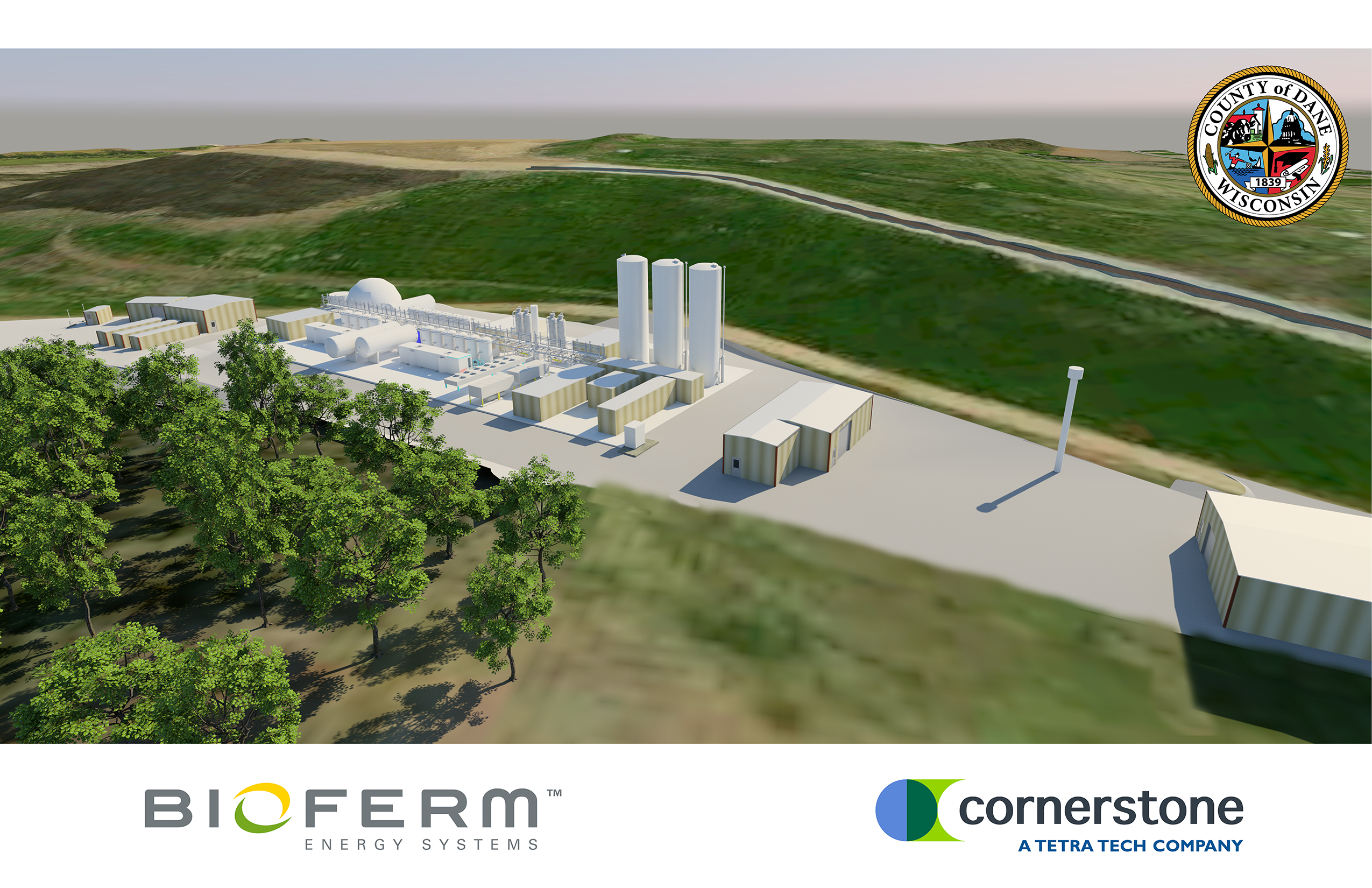
Dane County Executive Parisi Kicks Off Construction of First of its Kind Project in the Nation
Creates Economic Incentive for Development of Lakes Clean Up Efforts
Today, Dane County Executive Joe Parisi kicked off construction for an innovative project that will turn garbage and cow manure into renewable fuel for thousands of vehicles across the region and country. This project is also expected to significantly increase our lakes clean-up efforts by increasing revenue opportunities for local biogas digesters.
“Taking cow manure and garbage and turning it into vehicle fuel is good for the air we breathe, the waters we fish and swim in, and county taxpayers,” Parisi said. “Dane County is committed to accelerating work to clean up our lakes and financing efforts to produce renewable energy, and this project does both.”
Design work of the new facility is complete, BIOFerm has started ordering its system components, and the remainder of the project is out for bid now. Construction is expected to begin in the coming weeks with the system online by spring of 2019.
Dane County announced this today at a press conference with project partners Cornerstone Engineering, Clean Fuel Partners and Bioferm Energy, who is designing and supplying the biogas cleaning system for the project.
“BIOFerm is honored to be building this amazing green project for the County landfill which will serve as a beacon for all municipalities on how to maximize resources,” said Nadeem Afghan from BIOFerm. “We are proud to be a local company working to deliver this project and creating great economic value and jobs in the process. This project once completed will have the capability to deliver ½ billion gallons of clean transportation fuel which would be a great contribution by Dane County to save our environment from fossil fuel economy.”
The Dane County landfill currently generates electricity with the gas collected from the breakdown of garbage and organic material. Presently, the landfill makes enough electricity to power 4,500 homes. This new facility will enable the County to convert its landfill gas into vehicle fuel, thereby eliminating thousands of tons of carbon emissions, a leading cause to the extreme weather events triggered by climate change. In addition to the project’s environmental benefits, it is estimated the county will generate enough revenue from the project to payback its $25 million cost of the project in just a few years. That creates economic opportunity for both Dane County taxpayers and owners of “Cow Power” facilities north of Lake Mendota to convert their operations to gas production.
The County’s 2018 budget included the final phase of funding totaling $23.5 million for Dane County to build a biogas processing facility at its landfill and connect it with an adjacent interstate pipeline. That facility will clean up all of the collected landfill gas and turn it into renewable vehicle fuel. Of the total $23.5 million cost, $5.5 million is new funds in the 2018 budget. Those additional funds will allow the county to build a gas off-loading station where other biogas producers, like dairy digesters located in the North Mendota watershed, can bring their cleaned up fuel and have it injected into the pipeline. The gas would first need to be purified and compressed by the owner’s equipment before being hauled to the landfill for injection into the interstate pipeline.
This Dane County project is the first in the nation to be able to receive biogas from multiple off-site locations and connect that renewable gas with CNG gas stations locally and across the nation.
The 2018 county budget also included a $200,000 study to look into where additional digesters could be located to process manure into biogas. This will keep more manure off the land, reducing phosphorus on fields prone to runoff during heavy rain events that can get into waterways and cause algae blooms.
“Dane County continues to find game changing solutions to protect our lakes, produce renewable energy, and reduce climate change emissions,” said Jessica Niekrasz, Chief Administrator Officer of Clean Fuel Partners, whose company purchased the community digester near Waunakee in late 2015. “Our innovative private-public partnership with family-owned dairy farms will continue the work to economically remove phosphorus from the watershed.”
Digesters reduce greenhouse gas emissions by collecting and destroying methane that would otherwise be emitted to the atmosphere. They also help farms manage manure more responsibly, which reduces harmful runoff to lakes and streams. The county’s new facility at the landfill will make it economically feasible for manure digesters in the county to continue to produce renewable energy, reduce greenhouse gas emissions, and clean up our lakes.
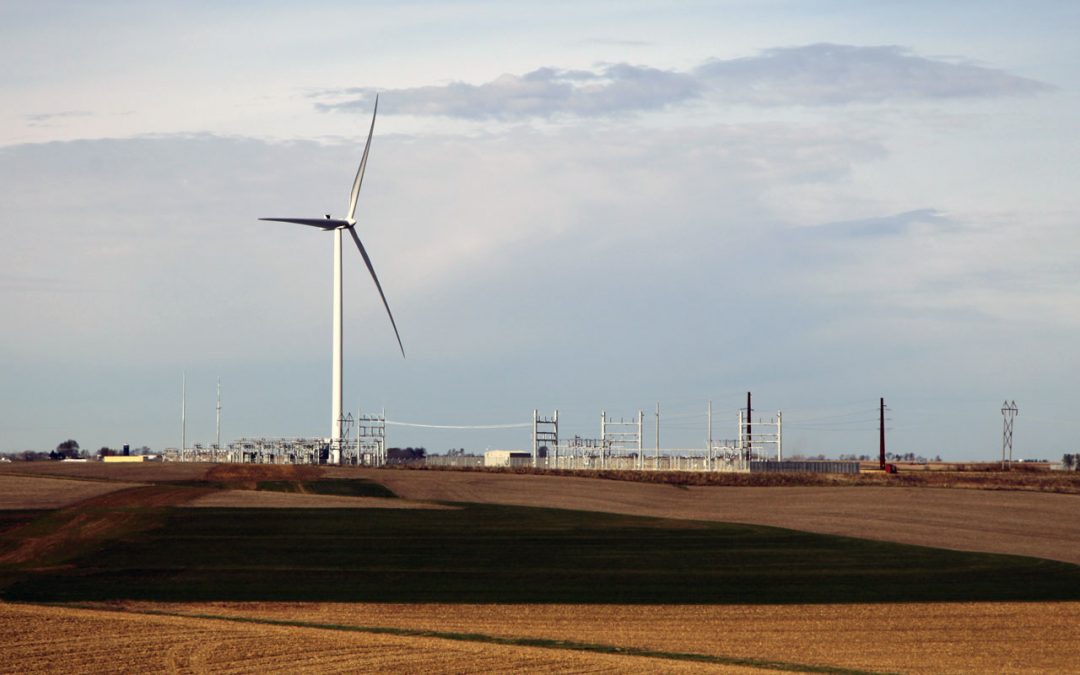
by Michael Vickerman | Mar 29, 2018 | Renewables, Solar, Utilities, Wind
A commentary by Tyler Huebner and Michael Vickerman
March 28, 2018
Kohler Co., a signature Wisconsin manufacturer, is set to join the dozens of U.S. corporations buying renewable electricity to displace fossil fuel generation on the electrical grid. But the source of this clean energy is nowhere near the company’s headquarters in Kohler. The wind farm that will sell this electricity to Kohler is instead located in east central Kansas, nearly 800 miles away.
A leading manufacturer of kitchen and bath products worldwide, Kohler recently entered into a 15-year contract with Enel Green Power North America to purchase electricity generated from a 300-megawatt (MW) wind power plant now under construction. Kohler’s share of Enel’s Diamond Vista wind farm is 100 MW, which will produce enough zero-emission electricity to equal the consumption of nearly 40,000 typical households.
Like many other corporate wind purchases, however, the electricity bought by Kohler will not directly supply its own operations. Instead, Kohler will resell the wind generation it buys to the wholesale electric market serving the Southern Plains states.
At the same time, Kohler will retain the renewable energy credits (RECs) associated with the output. These credits will be used to offset the greenhouse gas emissions from the electricity actually used to power all of the company’s U.S. and Canadian operations, including its flagship manufacturing facility in Kohler, Wisconsin, as well as its nearby golf and resort properties. This action will reduce Kohler’s global carbon footprint by 26%.
This is by far the largest renewable energy purchase undertaken by a Wisconsin corporation, befitting an industry leader that has embraced a goal to become net carbon neutral by 2035. With more than 50 manufacturing locations worldwide, Kohler is on the lookout for innovative pathways that can achieve substantial greenhouse gas emissions with minimal impact on its bottom line.
Corporations Looking for Renewable Energy At-Scale
The economies of scale achieved by large wind projects like Diamond Vista is quite appealing to Kohler and other corporate offtakers of renewable energy. In another example of this trend, the global beer giant Anheuser-Busch committed in fall 2017 to purchase RECs from the Enel-owned Thunder Ranch wind power project under construction in Oklahoma. That transaction will enable Anheuser-Busch to reduce emissions from its electricity purchases in the United States by 50% (and garnered this logo on each bottle and can of Budweiser now sold in the U.S.)

In addition to its environmental benefits, Kohler’s purchase will set in motion a significant economic jolt that will last throughout Diamond Vista’s operating life. Unfortunately, these economic benefits will be reaped entirely by the host communities in rural Kansas, bypassing Wisconsin altogether.
Wisconsin Renewable Projects Coming Online
The recently commissioned Quilt Block wind farm in southwest Wisconsin exemplifies the economic development potential represented by renewable generation. The largest power plant energized in Wisconsin last year, this 98 MW installation will, over its lifetime, direct millions of dollars in landowner payments and tax revenues into the coffers of both Lafayette County and the host township. At the same time, Quilt Block will supply La Crosse-based Dairyland Power Cooperative and its members with clean, affordable electricity under a long-term contract.
As it happens, the developer of Quilt Block, Houston-based EDP Renewables, would like to develop additional projects near where this project was just completed. In addition, numerous solar developers are eyeing opportunities to build large-scale solar in Wisconsin. These projects could, in theory, supply local corporate or institutional customers with the renewable power they are seeking, while strengthening the local economy where the projects are built. That certainly has all the earmarks of a win-win proposition for Wisconsin.
Two Models for Wisconsin’s Success
There are two models in early stages that could facilitate these win-wins for Wisconsin companies and local economies.
The first option is a “Corporate Renewable Energy Service,” which electric utilities can put in place to connect larger customers with low-cost renewable power generated from solar arrays or wind farms located in Wisconsin. These three-party arrangements connect the corporation (or local government), the utility, and a specific renewable energy project. The benefit to the company is a relatively seamless, and perhaps cost-neutral, arrangement that flows the energy production through on their existing utility bill.
We supported Madison Gas & Electric as they pursued such a service in 2017. However, they remain the only utility explicitly offering this service in Wisconsin. We need other utilities to design and offer this type of service to enable Wisconsin-based companies to connect to home-grown renewable projects.
The second model was trail-blazed by Organic Valley last year. OV, a farmer-owned food cooperative headquartered in La Farge, Wisconsin, recently agreed to purchase RECs from new solar arrays supplying power to a consortium of municipal electric utilities in southwest Wisconsin and Minnesota.
This amounts once again to a three-party arrangement. Two separate agreements are needed: the utility and the renewable energy project owner reaches an agreement on energy price, while the corporation desiring renewable energy strikes an agreement with the wind/solar project developer on the price for the separate renewable energy credits. One difference is that the utility bill for the corporation is unchanged, while they have a new expense for the purchase of the RECs.
Compared with Kohler’s 100 MW purchase, the 12 MW of renewable generation leveraged by the Organic Valley purchase is modest, but it could serve as a model for other state-based companies and local governments to embrace.
Both of these models have merits. For a company like Kohler seeking to offset its entire North American footprint of electricity consumption, a REC model makes tremendous sense. They were able to facilitate one REC deal that substantially accomplishes their goal as opposed to working through many utilities that serve their operations throughout the continent. (It’s also important to note that Kohler plans to continue its industry-leading energy efficiency efforts and explore on-site renewable generation as well.)
What’s clear is that Kohler and Organic Valley are just the beginning for Wisconsin companies seeking large amounts of renewable energy.
Wisconsin’s whole economy will benefit most if we can maximize the number of in-state projects to serve these Wisconsin-based companies. Now is the time for our electric utilities and large corporations to work together to facilitate in-state success stories for achieving corporate sustainability goals while building Wisconsin’s local economies.
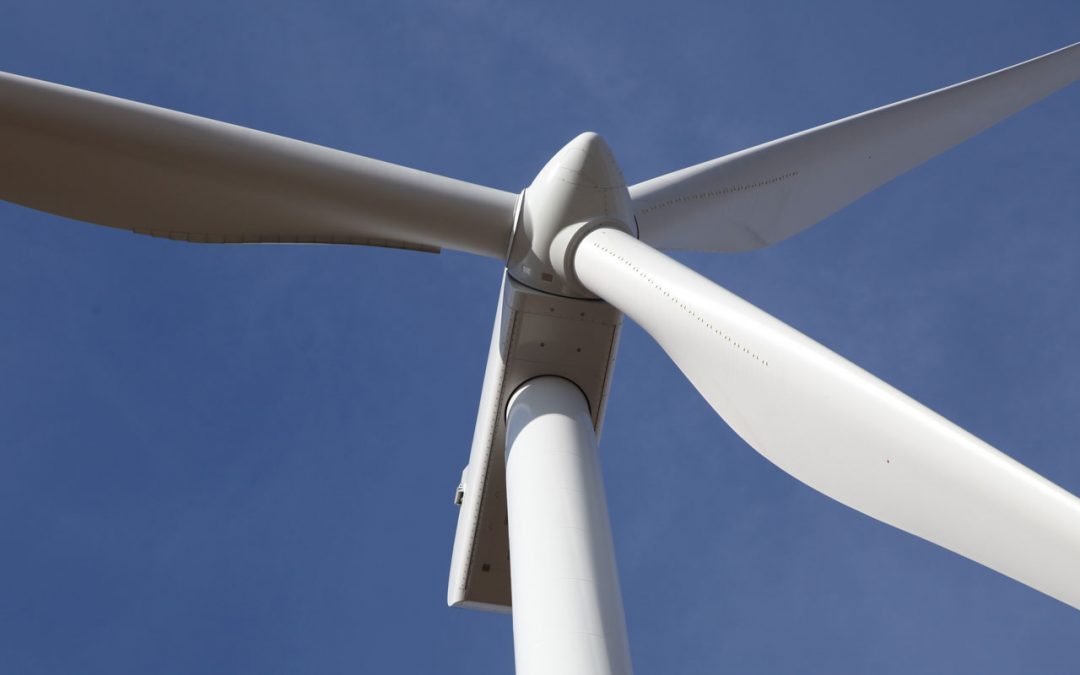
by Michael Vickerman | Feb 23, 2018 | Renewables, Solar, Utilities, Wind
Madison Gas & Electric’s efforts to transition to a low-carbon energy resource mix are accelerating, as documented in recent correspondence from company president and CEO Jeff Keebler. These sustainability initiatives will, according to Keebler, enable MGE to reduce carbon emissions by 40% by 2030 (base year 2005), a central objective of the company’s Energy 2030 framework. Beyond that, Keebler states that MGE will continue its pursuit of deep decarbonization through 2050, the year it aims to have achieved an 80% reduction in carbon emissions from 2005 levels.
A number of initiatives highlighted in MG&E’s letter stand out.
- Ground has been broken on the company’s 33-turbine, 66 megawatt (MW) wind power plant in northeast Iowa. The Public Service Commission (PSC) approved MGE’s application to build its Saratoga wind farm in November.
- The PSC is reviewing a request from MGE and two other utilities to purchase the Forward Wind Energy Center located in Fond du Lac and Dodge counties. Chicago-based Invenergy built the 86-turbine, 142 MW project, which started producing electricity in May 2008. The PSC is likely to approve the sale next month.
- MGE is teaming up with WEC Energy Group, the state’s largest electric utility, to build and own solar projects that will when completed become the largest of its kind in the state. MGE’s share of these installations will amount to 50 MW, which is expected to generate enough electricity to match the annual usage of 16,500 households. Across Wisconsin today, solar generating capacity totals 85 MW. This project will require PSC approval.
MGE is also working with larger customers to supply them with electricity from new renewable energy sources built in the utility’s service territory. Under MGE’s Renewable Energy Rider program, commercial customers should be able to access renewable electricity produced off-site at a cost comparable to standard service.
Finally, MGE is partnering with the City of Madison to accelerate the electrification of the latter’s bus fleet. Madison’s first three electric buses will arrive in 2019. Electrification of fleet vehicles is one of the areas of collaboration specified in a bilateral Memorandum of Understanding taking effect in September 2017.
For more information on MGE’s sustainability initiatives, visit www.energy2030together.com
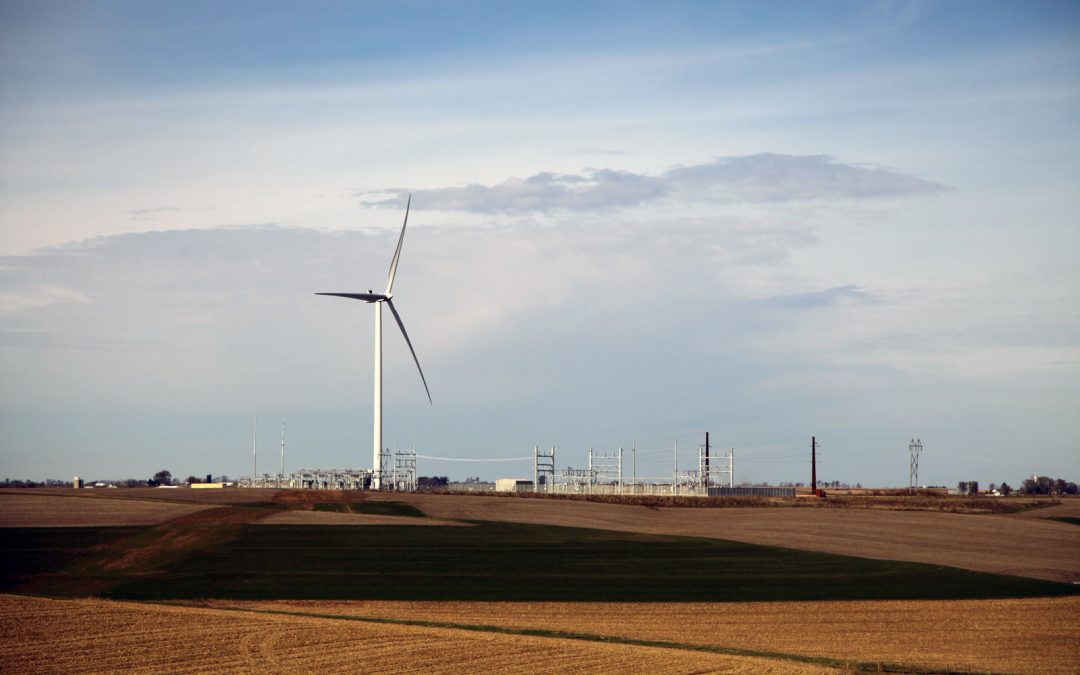
by Michael Vickerman | Feb 8, 2018 | Wind
As reported in the American Wind Energy Association’s (AWEA) most recent snapshot of market activity, U.S. developers and electric utilities installed more than 4,000 megawatts (MW) of wind power capacity in the fourth quarter of 2017, accounting for more than half of the total wind generation placed in service over the last 12 months. In the final three months of 2017, 29 new wind farms came online across 16 states, including the 49-turbine, 98 MW Quilt Block project in southwest Wisconsin.
The 7,000 MW of wind turbines built last year pushed total U.S. capacity to more than 89,000 MW, which in an average year should produce enough electricity to equal the annual consumption from 26 million households. Wind power accounts for more than 8% of U.S. generating capacity in the United States today according to the U.S. Energy Information Administration.
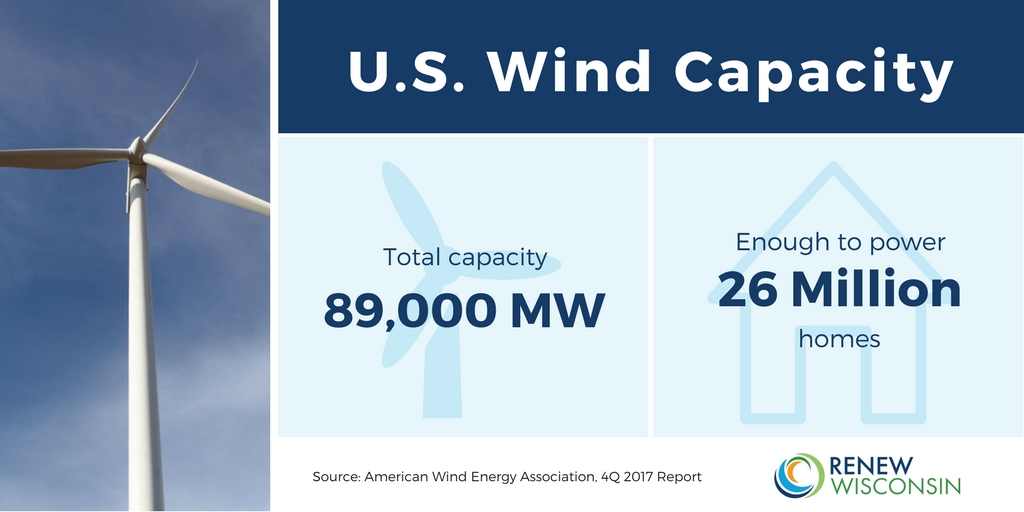
Development activity last year was particularly robust in the states of Texas, Oklahoma, Kansas, and Iowa. Large wind energy projects also sprouted up across the Upper Midwest, the second-most active region after the Southern Plains states.
Quilt Block is the first utility-scale wind energy installation to come online in Wisconsin since WEC Energy’s Glacier Hills project in 2011. Owned and operated by Houston-based EDP Renewables, Quilt Block is now the most productive wind power project in the Badger State. La Crosse-based Dairyland Power Cooperative purchases the output from this project to supply the distribution cooperatives and municipal utilities in its system.
According to the AWEA report, the powerful growth experienced by the wind industry last year should continue in 2018 and beyond. The pipeline of wind farms under construction or in advanced development totals 28,668 MW, about one-third of the wind generating fleet now operating in the United States. Projects in the development pipeline should be completed and operating before the end of 2019.
Said AWEA ceo Thomas Kiernan in a press release: “This American success story will continue, with the wind project construction and advanced development pipeline four times greater than the amount installed in 2017. That means tens of billions in additional infrastructure investment is on its way to the United States of America.”
Among Upper Midwest states (see table below), the near-term outlook for future wind development ranges from very active (states beginning with the letter “I”) to quiet (Missouri and Wisconsin). In Wisconsin, there is no project in the development pipeline right now, a consequence of the ongoing absence of policy drivers for renewables and the comparative ease of permitting and building wind projects in neighboring states. It should be noted that two Wisconsin utilities are planning to add wind power to its power supplies this year, Madison Gas & Electric from a 66 MW installation in Iowa, and WPPI Energy from a 132 MW project in Illinois.
